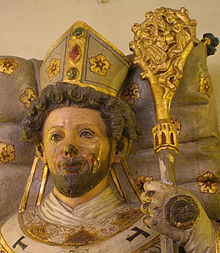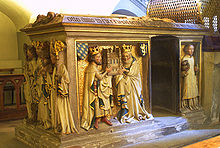Otto von Bamberg

Otto I von Bamberg , also Otto von Mistelbach , (* around 1060; † June 30, 1139 ) was bishop of the exemte diocese of Bamberg . He is also known as the " Apostle of Pomerania ". Otto was canonized in 1189 .
Life
According to the sparse information provided by the chroniclers, he came from a wealthy Swabian family of nobles from the Albuch area . All attempts to determine his place of birth exactly have remained open to doubt due to the poor sources. There is a tendency to localize it not in Swabia but in Franconia (see also Mistelbach (noble family) ). Presumably he was trained at Hirsau Abbey or one of its branches.
In research, the thesis is discussed that his mother Adelheid is the same person as Adelheid, the daughter of Friedrich von Büren , ancestor of the Staufer family. This would make Otto von Bamberg a cousin of Duke Friedrich II of Swabia and King Konrad III .
In 1088 Judith , the sister of Emperor Henry IV , married the Polish Duke Władysław I. Herman . Otto went with her as chaplain to the court of Vladislav. Then in 1091 he was called to the court of Henry IV. Otto became its chancellor and directed the construction of the cathedral at Speyer . In 1102 he was appointed the eighth bishop of Bamberg by the emperor. At that time the diocese was in a bad state and had widely dispersed, difficult to administer properties. In order to consolidate his territory, Otto founded and reformed numerous monasteries , including the Arnoldstein Abbey , and had numerous castles built. He had the Bamberg Cathedral from the time of Emperor Heinrich II burned out in 1081 renewed. In 1109 Otto consecrated the Bamberg St. Jacob's Church .


Otto tried to mediate in the investiture dispute between Pope and Emperor. In 1106 he was ordained Bishop of Anagni against his will during his trip to the Pope of Paschal II . Since he had stood on Henry V's side in the renewed investiture dispute between the emperor and the pope , he was removed from his offices at the synod in Fritzlar in 1118 by the papal party under the leadership of the cardinal legate Kuno von Praeneste . He played a key role in the resolutions of the Worms Concordat of 1122.
Otto succeeded in Christianising Pomerania : When the Polish Duke Bolesław III. Schiefmund subjugated the pagan, until then independent Pomerania in 1121/1122, he had an interest in the Christianization of the country. The missionary trip to Pomerania by a Bishop Bernhard from Spain was unsuccessful. Duke Boleslaw then approached Otto with a request to Christianize the country. Otto came to Pomerania on two mission trips, 1124 to 1125 and 1128. He baptized numerous people and destroyed the temples of the Slavic gods . Otto is still venerated today as the apostle of the Pomerania .
Otto denounced pagan customs in Pomerania such as polygamy, the killing of newborn girls, sorcery and divination, idolatry and the building of idol temples. His biographer Herbord describes his approach in Stettin : The bishop and his priests initially began to tear down the holy places, armed with axes and lances. After the population saw that their gods did not "fight back", they joined the attack. At the request of the Stettiners, Otto left only one holy oak standing on the condition that he should no longer practice oracles under the tree.
Otto is considered the most important of the Bamberg bishops. His grave is in the Bamberg Benedictine Abbey Michelsberg , which he had renewed between 1117 and 1121 after an earthquake and which he himself chose as a burial site during his lifetime. In the high grave from 1340 there is a hatch that enables pilgrims to get as close as possible to the relics. It is said that whoever crawls under the grave will be relieved of back problems.
Adoration
Otto was canonized in 1189. His Protestant and Roman Catholic memorial day is June 30th, and September 30th in the diocese of Bamberg . He is one of the two patrons of the Archdiocese of Berlin .
The Ottenkirche , which existed in Stettin from 1346 to 1575 , was consecrated to St. Otto.
Representations by Otto von Bamberg
A contemporary depiction of Otto von Bamberg can be found within the Romanesque wall paintings in the high choir of the St. Georg monastery church in the former monasteryChecking , Regensburg, which were created around 1130. The monastery was founded by Bishop Otto I around 1119.
Monuments to Otto von Bamberg can be found in several cities. In Bamberg there are monuments on Ottoplatz, in front of the kindergarten in Jäckstraße and in front of the St. Otto parish church and the Ottobrunnen. There is also a statue of Otto von Bamberg at the Maximiliansbrunnen .
A bust of Otto created by the sculptor Walter Schott was located in the former Siegesallee in Berlin in monument group 1 with the founder of the Mark Brandenburg Albrecht the Bear as the main character and the Bishop Wigger von Brandenburg. Today this bust of Otto is in the Spandau Citadel .
Another monument stands in the courtyard of the Palace of the Dukes of Pomerania in Szczecin .
A memorial plaque for Otto was placed in the Walhalla near Regensburg .
Romanesque wall paintings in the former conventChecking in Regensburg. Otto von Bamberg can be seen in the lower center.
Romanesque wall painting (1130) in the former monasteryprüfung in Regensburg
Postage stamp (1955) : 25 years of the Diocese of Berlin
Nikolaikirche Gützkow , window with St. Otto from 1883
Representation of St. Otto as the namesake of King Otto of Greece from the House of Wittelsbach in the Cathedral of St. Dionysius Areopagita , Athens
Back of the bronze Hedwig medal of the Archdiocese of Berlin with the inscription "Diocese of Berlin - Hl. Petrus - Hl. Otto"
Patronage
- Bamberg parish church of St. Otto
- Hof (Saale) branch church St. Otto
- Ottobrunn parish church St. Otto
- Mischelbach branch church St. Otto
generally see: Ottokirche .
literature
- Franz Xaver Sulzbeck: Life of St. Otto, Bishop of Bamberg and Apostle of Pomerania. Manz, Regensburg 1865, ( digitized version ).
- Wilhelm Bernhardi : Otto (the saint) . In: Allgemeine Deutsche Biographie (ADB). Volume 24, Duncker & Humblot, Leipzig 1887, pp. 654-657.
- Johannes Kist: Prince and Archdiocese of Bamberg. Guide through their history from 1007 to 1960. 3rd, completely redesigned and significantly increased edition. Historischer Verein Bamberg, Bamberg 1962, pp. 31–38.
- Eberhard Demm : Reform monasticism and Slavic mission in the 12th century. Investigations in the sociology of values and the history of ideas on the lives of Bishop Otto von Bamberg (= historical studies. H. 419, ZDB -ID 514152-7 ). Matthiesen, Lübeck et al. 1970, (Berlin, Free University, dissertation, 1969).
- Klaus Guth : Otto, Hl. In: Biographisch-Bibliographisches Kirchenlexikon (BBKL). Volume 6, Bautz, Herzberg 1993, ISBN 3-88309-044-1 , Sp. 1368-1373.
- Bernd Schneidmüller : Otto I. In: New German Biography (NDB). Volume 19, Duncker & Humblot, Berlin 1999, ISBN 3-428-00200-8 , p. 669 f. ( Digitized version ).
- Lorenz Weinrich (Ed.): Heiligenleben for German-Slavic history. Adalbert von Prag and Otto von Bamberg (= selected sources on German history in the Middle Ages. Vol. 23). Scientific Book Society, Darmstadt 2005, ISBN 3-534-01422-7 .
- Ebo von Michelsberg : The Pomeranian Apostle Otto von Bamberg. The life of the bishop and confessor. Edited and translated by Lorenz Weinrich . Thomas Helms, Schwerin 2012, ISBN 978-3-940207-43-2 .
- Alois Albrecht (Ed.): Otto, the saint. Bishop of Bamberg 1002–1139 and Apostle of Pomerania 1124/1125 and 1128. Narrated, venerated and invoked through centuries. Fruhauf, Bamberg 2014, ISBN 978-3-00-047959-5 .
- Norms Posselt: Conference Report. Bishop Otto von Bamberg - historical and archaeological research on the change of faith in the 12th century. Symposium on the occasion of the 875th anniversary of the death of the Pomeranian missionary, Greifswald, 27. – 29. June 2014. In: Foundation in archaeological findings (= communications of the German Society for Archeology of the Middle Ages and Modern Times. 27, 2014). German Society for Archeology in the Middle Ages and Modern Times, Paderborn 2014, pp. 257–259, doi : 10.11588 / dgamn.2014.2.17042 .
Web links
- Literature about Otto von Bamberg in the state bibliography MV
- Works by and about Otto von Bamberg in the German Digital Library
- The Otto legend (28 panels in the Michelskirche Bamberg)
- Otto legend in a manuscript in the Bamberg State Library , compiled by Michelsberg Abbot Andreas Lang
- Ecumenical Lexicon of Saints
- Publications about Otto von Bamberg at Litdok East Central Europe / Herder Institute (Marburg)
Remarks
- ^ Klaus Graf : Contributions to the nobility history of the Heubacher area. In: Stadt Heubach (ed.): Heubach and Rosenstein Castle. History, tradition, landscape. Einhorn-Verlag Dietenberger, Schwäbisch Gmünd 1984, ISBN 3-921703-57-3 , pp. 76-89, 405-409, online .
- ^ Petke, Wolfgang: Chancellery, chapel and royal curia under Lothar III. (1125-1137) . Böhlau, Cologne 1985, p. 224 .
- ^ Oskar Eggert : History of Pomerania. Volume 1. Pommersche Landsmannschaft, Hamburg Hamburg 1974, ISBN 3-9800036 , pp. 60-61.
- ^ Herbord , Dialogus de vita Ottonis episcopi Babenbergensis 2, 30–31.
- ↑ Image: File: Albrecht Wiggerl.JPG , see also the list of groups of figures in Berlin's Siegesallee
| predecessor | Office | successor |
|---|---|---|
| Rupert |
Bishop of Bamberg 1102–1139 |
Egilbert |
| personal data | |
|---|---|
| SURNAME | Otto von Bamberg |
| ALTERNATIVE NAMES | Otto von Mistelbach; St. Otto; St. Otto |
| BRIEF DESCRIPTION | Bishop of Bamberg, saint |
| DATE OF BIRTH | around 1060 |
| PLACE OF BIRTH | Francs |
| DATE OF DEATH | June 30, 1139 |
| Place of death | Bamberg |









